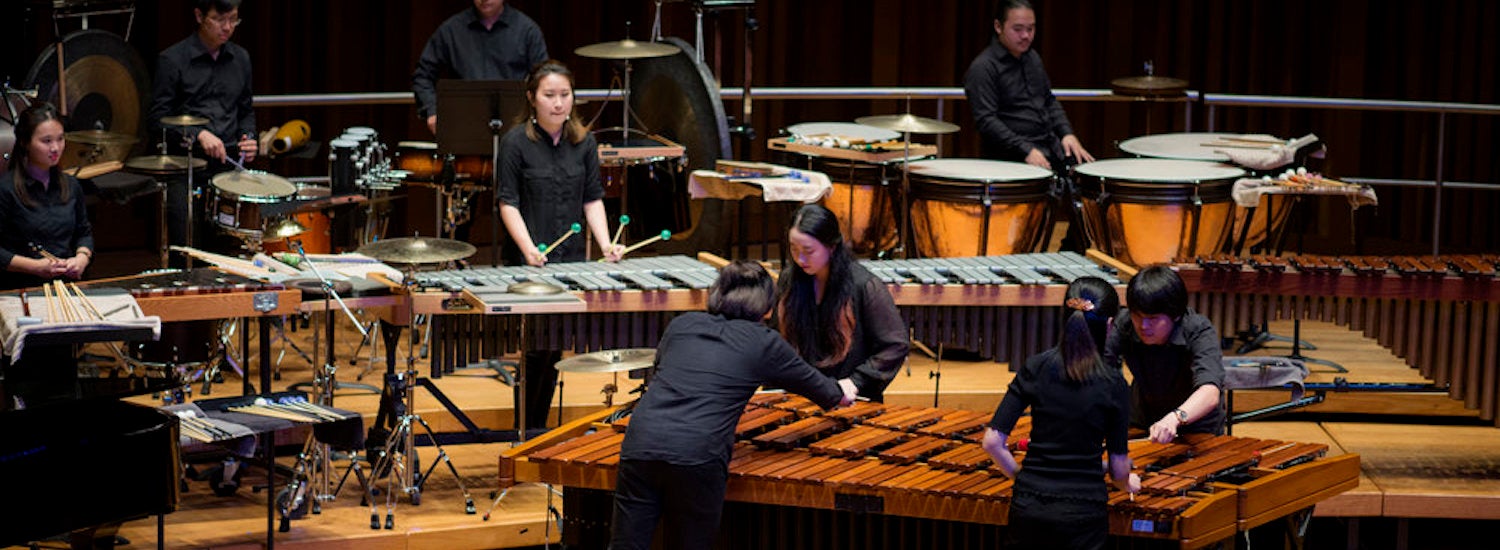MAJORS
Percussion

Students in the Percussion area receive holistic training that builds not only performance excellence, but also strong capabilities in the context of ensemble music-making, contemporary music, and non-Western musical cultures. They further build their capabilities in the areas of community engagement, orchestral pedagogy, and musical leadership.
This is complemented by opportunities to hear from and work with top-notch artists and ensembles, which have included Steven Schick, Vanessa Tomlinson and Trio SurPlus. Our students perform frequently within the Conservatory as well as in venues and community outreach platforms across Singapore. In addition, students receive support to pursue overseas development opportunities and projects.
Programme Structure
Students work individually with their Major teachers to build performance excellence, which is reinforced through weekly studio classes and online self-reflection, and supported by their community of student-colleagues. The Percussion curriculum also builds professional skills, from exploring percussion traditions to providing exposure to music-making in orchestral, contemporary music and non-Western musical contexts. These studies are accompanied by regular performance opportunities, including junior and senior recitals, as well as involvement in the YST’s vibrant calendar of events.
All percussions players also perform with our large ensembles – the Conservatory Orchestra, and the Conservatory’s contemporary music ensemble OpusNovus, which expose students to the music of the 18th through 21st centuries. Through chamber music class, students can proactively explore small ensemble music-making under the guidance of chamber coaches.
Elective courses and student development opportunities allow student further avenues to develop personal interests and strengths, including pedagogy, musical entrepreneurship, community engagement, and local and regional outreach.
Bachelor of Music – Percussion
MAJOR AND COLLABORATIVE ACTIVITY (72 MCS)
Major Study - 52 MCs
7 semesters of major study x 6 MCs per semester - 42 MCs
Final semester of major study - 10 MCs
Includes classes in Exploring Percussion Traditions, Percussion Set-ups and Maintenance, Percussion in Asian Contexts, and Percussion in Orchestral Contexts.
Collaborative Activity – 20 MCs
2 semesters of Orchestra – 4 MCs
2 semesters of OpusNovus – 6 MCs
2 semesters of Chamber Music – 6 MCs
1 semester of Orchestral Pedagogy – 4 MCs
* OpusNovus is a YST contemporary music ensemble dedicated to performing new repertoire.
MUSIC STUDIES REQUIREMENTS (36 MCS)
MUH1101 Foundations for Musical Discovery - 4 MCs
MUT1101 Introduction to Musical Concepts & Materials - 4 MCs
Any 3 Analysis & Composition modules from the following x 4 MCs each - 12 MCs
MUT2201 Harmonic Practices - 4 MCs
MUT2202 Counterpoint Through the Ages - 4 MCs
MUT2203 Texture and Timbre - 4 MCs
MUT2204 Formal Practices - 4 MCs
MUT2205 Text and Music - 4 MCs
1 additional Contextual Studies module - 4 MCs
4 Professional Integration modules - 12 MCs
MUA1163 Profession of Music 1 - 2 MCs
MUA1167 Profession of Music 2 - 2 MCs
MUA2163 Leading and Guiding Through Music - 4 MCs
MUA3163 Musical Pathways - 4 MCs
UNIVERSITY REQUIREMENTS (20 MCS)
5 General Education modules x 4 MCs each - 20 MCs
UNRESTRICTED ELECTIVES (32 MCS)
e.g. 8 Unrestricted Electives x 4 MCs each - 32 MCs
Examples of percussion-related electives:
MUA2205 Rhythmic Devices in Performance – 2 MCs
MUA3181 Advanced Concepts in Orchestral Repertoire – 4 MCs
MUA3205/3206 Jazz Study and Performance – 4 MCs
MUA3219/3220 World Music Ensemble – 2 MCs
MUA4108 Leadership Skills in an Orchestral Context – 4 MCs
Entry Requirements
At YST, our student selection criteria evaluates a range of factors in an application portfolio, including the candidate’s intellectual aptitude, curiosity, energy, artistic drive, relationship with people, linguistic proficiency and personal qualities that will contribute value to the cohort.
In addition to seeking the best emerging musical talents locally and in the region, our audition process is tailored to discover aspiring applicants with potential for developing a viable future professional and artistic identity.
Beyond evident current capacity in the applicant’s Major field, we explore how our programme resonates with them.
Click the following button for our admissions requirements.
AUDITION REQUIREMENTS
Live auditions in Singapore and some overseas locations take place from the immediately-preceding December to February period. View our admissions and academic timeline here.
1. Snare Drum
Two contrasting solos or etudes demonstrating snare drum rudiments and rolls.
E.g. Mitchell Peters – Intermediate Snare Drum Studies; Charley Wilcoxon – Modern Rudimental Swing Solos; Jacques Delecluse – 12 Studies for Snare Drum; Garwood Whaley – Audition Etudes
2. Keyboard Percussion
Choice piece: One solo or etude demonstrating either 2‐mallet or 4‐mallet technique.
E.g. Nebojsa Zivkovic – Funny Marimba; David Friedman – Dampening and Pedaling Technique for Vibraphone; Emmanuel Sejourne – 19 Etudes musicales de Vibraphone; J.S. Bach – A selection from a Cello Suite on Marimba
3. Choose ONE of the two options below (i.e. A or B):
A) Timpani – particularly if you are interested in an orchestra-focused curriculum.
I. Solo piece of choice e.g. Nick Woud – Musical Studies for Pedal Timpani, Symphonic Studies for Timpani
II. Additional timpani requirements: Demonstrate tuning skills and rolls of all pitch ranges and dynamic.
B) Another area of percussion expertise – particularly for those interested in the classical training that YST has to offer, but who may have special expertise outside the traditional orchestral curriculum e.g. drumset, multi‐percussion setup, tabla, congas.
I. A solo/etude that demonstrates your expertise on your chosen instrument.
II. A second notated, un‐notated, or improvised piece that demonstrates your stylistic/contextual mastery of your chosen instrument.
Gallery
YST CONSERVATORY
National University of Singapore
3 Conservatory Drive
Singapore 117376